The 'Previous Queries' panel has 2 tabs. 'Previous Queries' tab, which lists all queries run by the user,
and 'Find' tab, which allows the user to search for their previous queries.
6.1 'Previous Queries' tab
The 'Previous Queries' tab displays queries run by a user, with the most recent ones listed first. Results associated with the query can also be viewed in this tab. Both a standard i2b2 query (  ) and a Temporal query (
) and a Temporal query (  ) will appear in the 'Previous Queries.' Please see 3. 'Query Tool' for query types.
) will appear in the 'Previous Queries.' Please see 3. 'Query Tool' for query types.
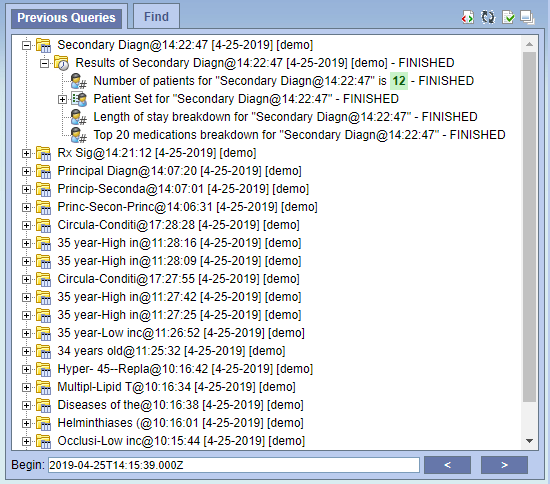
6.2 Find tab
The 'Find' tab provides previous query search interface. In the first combo box (  ), users can select one of the search options; search from the 'Previous Query Name', 'Previous Result Type', 'Patient Number', or any of the above categories. The second combo box (
), users can select one of the search options; search from the 'Previous Query Name', 'Previous Result Type', 'Patient Number', or any of the above categories. The second combo box (  ) allows users to set the input keyword match options; 'Containing', 'Exact', 'Starting with', or 'Ending with'. It returns the search results in the same format as 'Previous Queries' tab display.
) allows users to set the input keyword match options; 'Containing', 'Exact', 'Starting with', or 'Ending with'. It returns the search results in the same format as 'Previous Queries' tab display.

...
- Enter a search keyword in the input box (
 )
) - Press 'Find' button
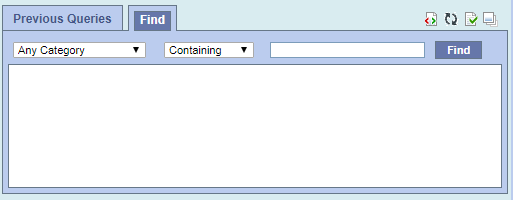
6.3 Layout of a Previous Query DisplayA previous query (  /
/  ) is created when a query is run from the 'Query Tool'. These previous queries can be used to run new queries or to easily populate other panels.
) is created when a query is run from the 'Query Tool'. These previous queries can be used to run new queries or to easily populate other panels.

The query in the 'Previous Queries' panel is comprised of multiple hierarchical levels that can be seen by expanding each level of the tree. These levels are outlined below.
6.3.1 Previous Query NameThe name of the previous query is the top level of the hierarchal tree and is comprised of these three components.
- Query Name - the name given at the time the query was created. The default name contains an abbreviated description and the time the query was run.
- Date - the date the query was created.
- User Id - the user who created (ran) the query.

| Anchor |
|---|
| pqResultsFolder |
|---|
| pqResultsFolder |
|---|
|
...
6.3.2 Results Folder
The Results folder (  ) contains the results of the query. To see the query results simply expand the folder by clicking on the plus sign (
) contains the results of the query. To see the query results simply expand the folder by clicking on the plus sign (  ) located next to the result name.
) located next to the result name.
6.3.2.1 ResultsThe results associated with a previous query are determined by the query result type(s) that are selected when the query is run in the 'Query Tool'.
6.3.2.1.1 Patient SetThe Patient set (  ) appears if Patient set or Timeline was checked at the time the query was run. The set contains all the patients who met the defined search criteria.
) appears if Patient set or Timeline was checked at the time the query was run. The set contains all the patients who met the defined search criteria.
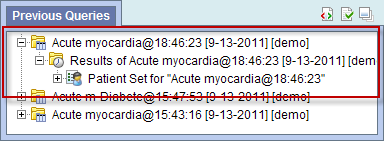
6.3.2.1.2 Encounter SetThe Encounter Set (  ) appears if Encounter set was checked at the time the query was run. The set contains all the patients whose encounters met the defined search criteria.
) appears if Encounter set was checked at the time the query was run. The set contains all the patients whose encounters met the defined search criteria.
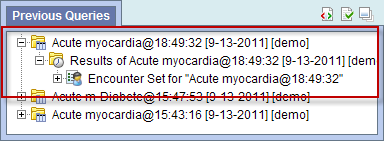
...
6.3.2.1.3 Number of Patients
The Number of Patients (  ) appears if Number of Patients was checked at the time the query was run. The results are a total count for those patients who met the defined criteria.
) appears if Number of Patients was checked at the time the query was run. The results are a total count for those patients who met the defined criteria.
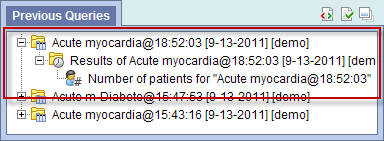
...
6.3.2.1.4 Breakdown
The breakdown (  ) appears if Gender / Vital Status / Race / Age patient breakdown was checked at the time the query was run. The results are a breakdown by gender / vital status / race /age for those patients who met the defined criteria.
) appears if Gender / Vital Status / Race / Age patient breakdown was checked at the time the query was run. The results are a breakdown by gender / vital status / race /age for those patients who met the defined criteria.

6.4 NavigationUsing the mouse right click on the 'Previous Queries' panel, users can open the Previous Queries Menu. 'Display,' 'Rename,' 'Delete' options act on the selected, or mouse hovered previous query. When the menu is called from a blank space, those menu options are applied to the previous target query.

6.4.1.1 DisplayUsers can see a previous query information by selecting Display from the popup menu. It loads its query name, the query design, and the results in the 'Query Tool' panel.
- Using the right mouse button, click on the Previous Query to be renamed.
- A pop-up menu will open.
- Select Display from the menu.
- The rename query dialog box will open.
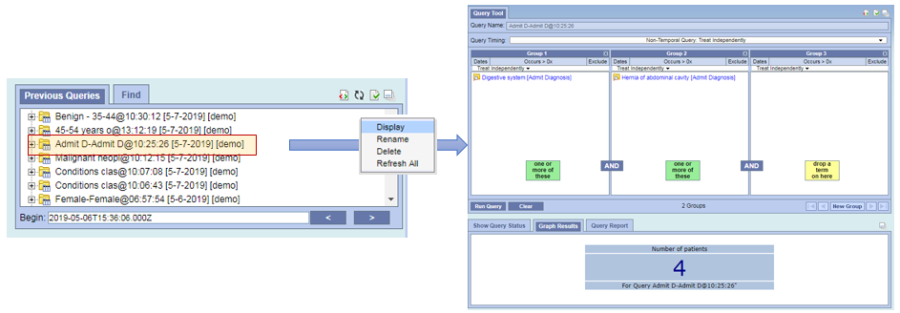
6.4.1.2 Rename a Previous Query
Users can rename a previous query from the list by selecting Rename from the popup menu.
...
- Enter the new name of the previous query and click on the OK button.
The previous query will now display in the view with the new name.
NOTE:
When dragging a previous query to another view the new name will appear when it is dropped. |
Delete 6.4.1.3 Delete / Remove a Previous Query
Users can rename a previous query from the list by selecting Delete from the pop-up menu. - Using the right mouse button, click on the Previous Query to be deleted.
- A pop-up menu will open.
- Select Delete from the menu.
- A message box will open asking if you are sure you want to delete the query.

Click on the OK button to delete the query
WARNING:
Once you click on Delete, the previous query will be removed from the view and there is no way to restore it. Therefore, you need to make sure you want to remove it from the list. |
Refresh 6.4.1.4 Refresh the List
Users can refresh the list of previous queries from the list by selecting Refresh All from the pop-up menu.- Using the right mouse button, click on any of the previous queries in the list.
- A pop-up menu will open.
- Select Refresh All from the menu.
- The list of previous queries and their status will be refreshed.
6.4.2 OptionsThe third right top button panel (  , the red circle in the following image) in the 'Previous Queries' prompts an Options window. Users can define how many previous queries to display, the order in which they will appear in the list, and auto refresh setting.
, the red circle in the following image) in the 'Previous Queries' prompts an Options window. Users can define how many previous queries to display, the order in which they will appear in the list, and auto refresh setting.
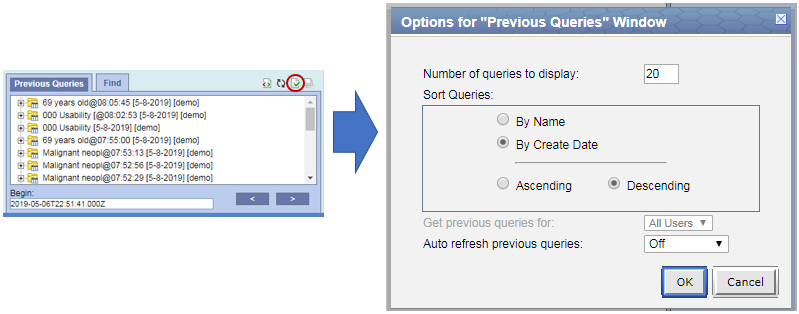
...
Users can turn off the auto refresh, or select the auto refresh frequency from the combo box.
NOTE:
If the auto refresh option is turned off, users need to use the refresh button (  ) to see the updated previous queries list. ) to see the updated previous queries list. |
Using a Previous Query
...












